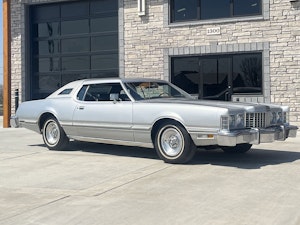Media | Articles
This Ruf CTR2 Is a Twin-Turbo 993 Like No Other
What do Jaguar, Ruf, and McLaren have in common? Each, at one point in the same ten-year span, built the fastest production car in the world. All were low-volume manufacturers, but the least widely known of the trio also built the fewest, most exclusive vehicles.
Meet the Ruf CTR2, a 993-generation rocket with a think tank’s worth of proprietary Porsche-tuning know-how. One of only 30 or so examples built—only the manufacturer in Pfaffenhausen knows the true total—this CTR2 is going up for sale late this summer, at Broad Arrow’s Monterey Jet Center sale in August.
Unlike Gemballa and other Porsche customizers that rose to fame in the ’80s and ’90s, Ruf is its own manufacturer, and its cars have Ruf-specific serial numbers. Founded in 1939 by Alois Ruf, Sr, the small shop in Pfaffenhausen, Germany began as a service station. Alois Ruf, Jr began working on Porsches in his father’s shop, and took over in 1974 upon his father’s death. He had a passion for tweaking cars from the Stuttgart brand, and the shop’s focus became modifying 911s for speed. (The shop put a five-speed gearbox in a turbocharged 911 before Porsche did, for one.) In 1981, Ruf was listed as a manufacturer by the German Federal Motor Transport Authority.

The Ruf name catapulted into global awareness in 1987 when Ruf released a video of a bright yellow 930-chassis 911, its air-cooled flat-six strapped with two turbos, tearing—often sideways—around Germany’s infamously challenging Nürburgring. In a test published later that year, Road and Track clocked the CTR at 211 mph around the 15.5-mile oval test track in Ehra-Lessien: That was about 13 mph faster than Porsche’s contemporary 911 Turbo, and faster than any vehicle (Ferrari Testarossa and Porsche 959 included) in the star-studded test gathering. The magazine editors dubbed the CTR “Yellow Bird”—and the name stuck. Soon after, Ruf decided to build 29 more, calling the model CTR.
The CTR2 is what happened when, in 1995, Ruf got its hands on the 993-generation 911. Ruf would fit the Porsche-supplied bodies-in-white with either rear- or all-wheel drive, whichever the customer preferred. To say that the shop’s engineering changes were extensive would be an understatement: Like the CTR, the flat-six in the CTR2 was twin-turbocharged and mated to a gearbox of Ruf’s own design, with new, lightweight body panels supported by a proprietary integrated rollcage. (For the CTR2, though, those panels were carbon-kevlar composite rather than aluminum and fiberglass.)
Marketplace
Buy and sell classics with confidence
The CTR2 demonstrated a new level of commitment to aerodynamics: The side-view mirrors were new and snuggled as close to the body as possible. For each Carrera 2 body-in-white that it received from Porsche, Ruf removed the rain gutters on the roof and welded the seams on the roof, changes that not only made the car look sleeker but also made it quieter at high speeds. The rear bumper, and the giant wing affixed to it, the rocker panels, and the front spoiler were all of Ruf design.
The CTR2 had its own moment of motorsports fame in 1997, when two specially modified examples placed second overall and fourth in class in the Pikes Peak International Hillclimb. (Double-decker wing, 702 bhp, and yellow paint!)





This brings us to today’s car, a silver-over-black CTR2 (chassis no. W09BD0364WPR06010) presented for sale by the same person who commissioned it from Alois Ruf in 1998. Given the chance to order the car however they liked, this discerning customer asked for a six-speed transmission made-to-order with gear ratios that prioritized acceleration over top speed, the optional four-wheel-drive system, and the lightweight, composite body panels. While this CTR2 is not billed as the Sport model, it does have the uprated, 580-hp engine developed for that later variant, as requested by the customer, who paid an additional 65,000 Deutsche Marks for the 60 extra horses. (Rufs are frequently sent back to the shop for further modifications, so clear differentiation between variants isn’t as clearly delineated as it would be for an outfit that worked in larger volumes.) Other build-specific details include the oval exhaust tip and a sound system made by Nokia.
The car is accompanied by all its original paperwork, including order forms, options list, a photograph of the owner and the Rufs standing next to the car upon its delivery, and even the handwritten calculations for the modified gear ratios. It is offered by Broad Arrow with an estimate of $2.2M–$2.5M.
Air-cooled Porsche 911s of all stripes have seen a dramatic rise in values over the last several years. Naturally, the fast, rare, and unique examples have led the way, and it’s no surprise that the Ruf CTR2 comes in at the top of the list.
***
Check out the Hagerty Media homepage so you don’t miss a single story, or better yet, bookmark it. To get our best stories delivered right to your inbox, subscribe to our newsletters.






































Ruf made some of the most interesting 911’s, especially of the air cooled era. That car is almost perfect. I don’t care for the “anus” exhaust on the back, two tips looks better.